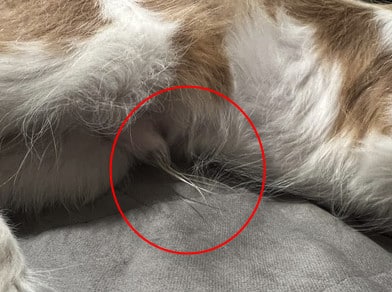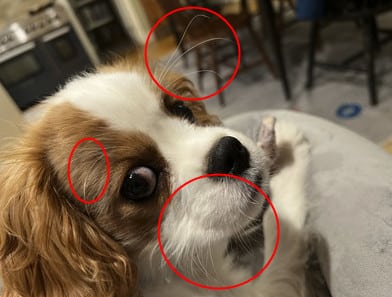Since we’re all adults, I’d like to discuss a few dog parts that have really good reasons why they should never be cut off a dog. Animals come with all the body parts they’re meant to have. If it’s there, it’s there for a reason. Certainly, none of the following should be removed for human vanity reasons.
1. Male Dog Penis Guide Hairs
 Some people feel compelled to trim male guide hairs (don’t know what the technical name is for this) because they either don’t like the way it looks or because after a dog pees, it can stay wet for a bit. Though most dogs quickly clean themselves, so it’s not an issue.
Some people feel compelled to trim male guide hairs (don’t know what the technical name is for this) because they either don’t like the way it looks or because after a dog pees, it can stay wet for a bit. Though most dogs quickly clean themselves, so it’s not an issue.
The hair is long to help direct the pee to the ground. When you cut this hair off, the pee has a tendency to spray over the dog’s stomach instead. This can cause matting and irritated skin if not cleaned daily.
Also be aware that if this hair grows back (sometimes it doesn’t) it grows back verrrry slowly.
So you may think you’re solving one problem of not liking the way it looks or worrying about a drop of pee landing on the floor, but you’re actually creating a much larger potential health problem which requires more time and attention.
2. Whiskers
Dog whiskers, also known as vibrissae, serve a variety of purposes, including helping the dog navigate and sense its environment. They are highly sensitive to touch and can detect changes in air currents, allowing the dog to sense objects in the dark or in low visibility. They also help the dog determine the size and shape of objects and spaces, as well as providing information about the texture and movement of objects. Additionally, they may also play a role in communication and social interactions with other dogs.
While it doesn’t physically hurt your dog to cut off their whiskers (they don’t contain pain receptors) they do serve an important purpose. They’re there to help your dog be more spatially aware. By cutting them off, you’re putting your dog at a disadvantage by making them less spatially aware. This could have the effect of making your dog a lot less confident. It can take up to three months for whiskers to grow back!
3. Dewclaws
It helps to think of dewclaws as the thumbs and big toes of dogs. They’re not directly equivalent but they can serve similar purposes. For example, when a dog is running and/or turning on slippery surfaces, dewclaws can provide extra traction and help stabilize the carpal (wrist) joint. Some dogs use their dewclaws to hold objects better when chewing. Some dog breeds use them to climb trees or climb out of the water if they’ve fallen through the ice.
So, clearly, these are not something that should be removed for vanity reasons. And yet it’s typically breeders who have their puppies’ dewclaws removed very early. This is often done at the same time ear cropping and tail docking are done.
4. Tails
Tail docking requires amputating part or all of a dog’s tail. It’s typically performed very early in a puppy’s life under general anesthesia by surgical amputation. Some breeders, though, opt to remove tails without anesthesia by putting tight rubber rings around the tail. This cuts off the blood flow to the tail causing ischemic necrosis. The tail essentially dies and falls off
Breeders may try to justify this practice, saying that it’s done to prevent tail injuries. This has been disproven by many recent studies. The truth is, it’s almost always done to conform to a breed appearance standard. Consider the following fact:
In the largest study to date on tail injuries in dogs the incidence was 0.23% and it was calculated that approximately 500 dogs need to be docked to prevent one tail injury.
According to Wikipedia, here are three important reasons not to dock tails:
- Docking tails puts dogs at a distinct disadvantage in several ways. First, dogs use their tails to communicate with other dogs (and with people); a dog without a tail might be significantly handicapped in conveying fear, caution, aggression, playfulness, and so on. Leaver and Reimchen, in 2007, found that longer tails were more effective than shorter tails at “conveying different intraspecific cues, such as those provided by tail motion”.[7]
- It has also been suggested that certain breeds use their tails as rudders when swimming, and possibly for balance when running; so active dogs with docked tails might be at a disadvantage compared to their tailed peers. Videos comparing docked and undocked dogs running and jumping show that dogs who are docked have to work harder to compensate for the loss of the tail.[8] Canine pathologist and sports-medicine expert Prof. Chris Zink believes the extra stress imposed on the joints can have long-term health consequences.
- In 2007, Stephen Leaver, a graduate student at the University of Victoria, published a paper on tail docking which found that tail length was important in the transmission of social cues. The study found that dogs with shorter tails (docked tails) would be approached with caution as if the approaching dog was unsure of the emotional state of the docked dog. The study goes on to suggest that dogs with docked tails may grow up to be more aggressive. The reasoning postulated by Tom Reimchen, UVic Biologist and supervisor of the study, was that dogs who grew up without being able to efficiently transmit social cues would grow up to be more anti-social and thus more aggressive.[9]
5. Ears
Ear cropping is an elective, cosmetic surgery where some part of a dog’s floppy ear is cut off. What’s left is stitched into the desired (usually erect) shape. We’ve gotten so used to seeing some breeds with their ears cropped (like Dobermans and Boxers) that we forget those are not the ears they were born with.
Breeders will often try to make the case that cropping (and docking) are done for functional reasons. When, in fact, it’s been perpetuated for “aesthetic” reasons.
For example, with boxers, consider this:
The original Boxer standard, adopted in Germany in 1902, confirms that the motivation for ear cropping is — and has been for at least the last 122 years — entirely aesthetic.
The literal translation from the German standard states, “This as well as the clipping of the tail is important because long ears give the dogs a sleepy expression which is very objectionable.” Read more here
These practices have already been banned in many other parts of the world. We all need to help US breeders move away from these practices by requesting and even insisting that our puppies come with all of their parts still attached.


Wow helpful when i get a dog